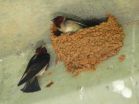(Press-News.org) There are clear advantages to living in cities: safety, ready availability of infrastructure, plenty of company etc. Nevertheless, a large number of people eschew them for the benefits of country life, such as clean air and lots of space. Many species of animals, and particularly birds, face the same choice between living in large groups or remaining in smaller ones, thereby avoiding disadvantages of larger colonies such as the increased risk of disease and increased aggression from neighbours. What causes different individuals of a particular species to take the decisions they do?
It's all in the genes
One possible explanation is that animals and birds might be genetically influenced to breed in smaller or larger colonies. This idea gained widespread acceptance in 2000, when Charles and Mary Brown reported the results of a field experiment of unprecedented scope. The Browns worked on Cliff Swallows, a species of American swallow that breeds in colonies of variable size. Some individuals appear to be more resistant to nest parasites so can breed in larger, more parasite-infested colonies where they can achieve higher foraging efficiencies by following their many neighbours to the insect swarms on which they feed. The scientists cross-fostered an astounding 2,000 nestlings from nests in small colonies to nests in large colonies and vice versa and recaptured over 700 of the birds when they returned to breed in the following years. Analysis of the data showed convincingly that swallows hatched in larger colonies (but reared in smaller ones) chose to breed in large colonies, whereas the reverse was true for swallows hatched in small colonies. In other words, the birds' choice is determined by genetic factors.
Or is it?
Appealing though the conclusion might be, something does not sound quite right. How would a genetic component of the choice of group size be selected and maintained throughout evolution? Étienne Danchin of the University of Toulouse and Richard Wagner of the Vetmeduni's Konrad Lorenz Institute of Ethology wondered whether the results might not be influenced too much by the experimental design. Together with Éric Wajnberg, a modelling specialist at the INRA in Sophia Antipolis, they simulated the data in the original paper and found that the results could be generated by chance.
The problem stems largely from the fallacy known as "regression to the mean" (RTM), which was first identified by Sir Francis Galton, a cousin of Charles Darwin, in the 19th century. It results from the fact that uncommonly large or small measurements are generally followed by more normal measurements simply because normal values are by definition far more common than extreme ones. In the Browns' experiment, when individuals are fostered from small to large colonies they will on average recruit to colonies that are statistically smaller than their foster colony because these are closer to the mean colony size and vice versa.
Danchin and Wagner actually found a second problem with the original data analysis. The so-called "spatial fallacy" was discovered by Arie van Noorwijk in 1984 and occurs when the set of potential dispersal sites differs among individuals according to where they were born. Together the two fallacies can account for the experiment's results, even in the absence of an inherited component of the selection of colony size.
A question of design
The latest calculations are important for two reasons. First, they call the original conclusions into question and should thus encourage researchers to reconsider the role of genetic factors in certain behavioural decisions. Secondly, they sound a clear warning to all those working in behavioural science. As Wagner says, "The biggest shock is that the very experimental design that is widely used to control for all extraneous effects actually creates the RTM fallacy. Even the most carefully designed studies can suffer from the problem, making their results invalid." Fortunately the scientists have proposed a way to avoid both pitfalls. Their simulations showed that restricting comparisons to individuals with the same set of options (in the present case by fostering all offspring to a single colony) can give rise to data that are immune to the pitfalls.
INFORMATION:
The Nature Publishing Group has just published the paper "Avoiding pitfalls in estimating heritability with the common options approach" by Étienne Danchin, Éric Wajnberg and Richard H. Wagner in its online journal Scientific Reports, where it is freely available (Scientific Reports Volume 4, doi:10.1038/srep03974), http://www.nature.com/srep/2014/140205/srep03974/full/srep03974.html
About the University of Veterinary Medicine, Vienna
The University of Veterinary Medicine, Vienna is the only academic and research institution in Austria that focuses on the veterinary sciences. About 1200 employees and 2300 students work on the campus in the north of Vienna, which also houses the animal hospital and various spin-off-companies. http://www.vetmeduni.ac.at
Scientific Contact:
Richard H. Wagner, PhD
Konrad Lorenz Institute of Ethology (KLIVV)
University of Veterinary Medicine, Vienna (Vetmeduni Vienna)
T +43 1 4890915-831
richard.wagner@vetmeduni.ac.at
Released by:
Susanna Kautschitsch
Science Communication / Public Relations
University of Veterinary Medicine Vienna (Vetmeduni Vienna)
T +43 1 25077-1153
susanna.kautschitsch@vetmeduni.ac.at
The importance of (experimental) design
2014-02-25
ELSE PRESS RELEASES FROM THIS DATE:
New study finds concussion-related health problems in retired football players
2014-02-25
New Rochelle, NY, February 25, 2014—Repeated concussions and mild brain trauma can result in reduced levels of growth hormone, gonadotropin, and thyroid hormones, causing disorders such as metabolic syndrome and erectile dysfunction and overall poor quality of life. The results of a new study of retired professional football players that compares number of concussions sustained during their careers and health problems associated with hormonal deficiency is published in Journal of Neurotrauma, a peer-reviewed journal from Mary Ann Liebert, Inc., publishers. The article is ...
Mother to child HIV transmission at record low in the UK
2014-02-25
The rate of mother to child HIV transmission is at an all-time low in the UK, according to a paper published today in the journal AIDS.
The study examined over 12 000 pregnancies in women diagnosed with HIV before or during pregnancy and delivered in 2000-2011; there was a four-fold drop in the rate of mother to child transmissions, from 2.1% in 2000-2001 to 0.46% in 2010-2011.
Dr Claire Townsend (UCL Institute of Child Health) said: "Mother to child HIV transmission is now at the lowest level ever in the UK & Ireland, and as far as we're aware such low levels have ...
System that automatically fills gaps in programmers' code gains power
2014-02-25
Since he was a graduate student, Armando Solar-Lezama, an associate professor in MIT's Department of Electrical Engineering and Computer Science, has been working on a programming language called Sketch, which allows programmers to simply omit some of the computational details of their code. Sketch then automatically fills in the gaps.
If it's fleshed out and made more user-friendly, Sketch could ultimately make life easier for software developers. But in the meantime, it's proving its worth as the basis for other tools that exploit the mechanics of "program synthesis," ...
NASA's SDO shows images of significant solar flare
2014-02-25
The sun emitted a significant solar flare, peaking at 7:49 p.m. EST on Feb. 24, 2014. NASA's Solar Dynamics Observatory, which keeps a constant watch on the sun, captured images of the event.
Solar flares are powerful bursts of radiation, appearing as giant flashes of light in the SDO images. Harmful radiation from a flare cannot pass through Earth's atmosphere to physically affect humans on the ground, however -- when intense enough -- they can disturb the atmosphere in the layer where GPS and communications signals travel.
To see how this event may impact Earth, please ...
Scientists explore promising new option for first line of attack in lymphoma
2014-02-25
A study led by Manchester scientists has shown promising results for a new treatment approach in follicular lymphoma.
Follicular lymphoma is a type of non-Hodgkin's lymphoma– a blood cancer - that usually develops slowly. The majority of patients are diagnosed when their disease is at an advanced stage.
Recent improvements in treatment have included the use of antibodies to specifically target the tumour cells and to stimulate the patient's own immune system to attack their tumour. The use of such antibodies has improved treatment response, but unfortunately most patients ...
Tumors 'light up' with new, unique imaging system using scorpion venom protein and a laser
2014-02-25
LOS ANGELES (Feb. 24, 2014) – Researchers at the Cedars-Sinai Maxine Dunitz Neurosurgical Institute and Department of Neurosurgery have developed a unique, compact, relatively inexpensive imaging device to "light up" malignant brain tumors and other cancers.
The experimental system consists of a special camera designed and developed at Cedars-Sinai and a new, targeted imaging agent based on a synthetic version of a small protein – a peptide – found in the venom of the deathstalker scorpion. The imaging agent, Tumor Paint BLZ-100, a product of Blaze Bioscience Inc., homes ...
Real time forecast of Hurricane Sandy had track and intensity accuracy
2014-02-25
A real-time hurricane analysis and prediction system that effectively incorporates airborne Doppler radar information may accurately track the path, intensity and wind force in a hurricane, according to Penn State meteorologists. This system can also identify the sources of forecast uncertainty.
"For this particular study aircraft-based Doppler radar information was ingested into the system," said Fuqing Zhang, professor of meteorology, Penn State. "Our predictions were comparable to or better than those made by operational global models."
Zhang and Erin B. Munsell, ...
The only top 10 cancer where survival rates are falling
2014-02-25
Of the top 10 cancers in the UK, bladder cancer is only one where survival rates have been shown to be getting worse. New figures published this month in the Journal of Clinical Urology confirm in a study of cases of bladder cancer in England over a 19 year period (from 1990 until 2009) that survival rates here in the UK are falling and are worse than in than in other European countries with similar incidence rates.
Shockingly, bladder cancer isn't a rare cancer that only affects a few people every year. In fact, bladder cancer is our 7th most common cancer (the 4th most ...
Study shows mentally ill more likely to be victims, not perpetrators, of violence
2014-02-25
New research shows that almost one-third of adults with mental illness are likely to be victims of violence within a six-month period, and that adults with mental illness who commit violence are most likely to do so in residential settings. The study also finds a strong correlation between being a victim of violence and committing a violent act.
The work was done by researchers at North Carolina State University; RTI International; the University of California, Davis; Simon Fraser University; and Duke University.
"We hear about the link between violence and mental illness ...
Anti-vaccine conspiracy theories may have 'detrimental consequences' for children's health
2014-02-25
A belief in anti-vaccine conspiracy theories may have significant and detrimental consequences for children's health, new research from the University of Kent has shown.
Researchers Daniel Jolley and Dr Karen Douglas, of the University's School of Psychology, surveyed 89 parents about their views on anti-vaccine conspiracy theories and then asked them to indicate their intention to have a fictional child vaccinated. It was found that stronger belief in anti-vaccine conspiracy theories was associated with lower intention to vaccinate.
In a second study, 188 participants ...


